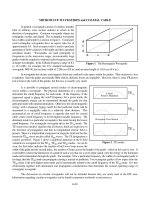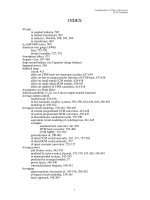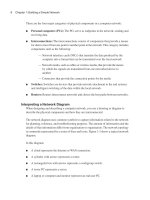Tài liệu Wireless Sensors and Instruments P2 pptx
Bạn đang xem bản rút gọn của tài liệu. Xem và tải ngay bản đầy đủ của tài liệu tại đây (452.28 KB, 10 trang )
Instruments and Instrumentation 25
Sputtering is similar to vacuum deposition. In this method, an inert gas
such as argon or helium is introduced into a chamber that contains anode
and cathode electrodes supplied by an external high-voltage source. The
anode contains the sample to be deposited on and the cathode contains the
deposited material. The principle is that the high voltage ignites a plasma
effect in the inert gas and the gas ions bombard the target containing the
material to be deposited. When the kinetic energy of the bombarding ions
is sufficiently high, some of the atoms from the target surface are freed and
carried by the gas to the surface of the sample. The sputtering technique
yields better uniformity, particularly in the presence of a magnetic field. This
method does not require high temperatures, so virtually any type of material,
including organic materials, or mixtures of different materials can be sput-
tered.
Chemical vapor deposition (CVD) is one of the most common methods
used for the fabrication of semiconductor-based sensors. It is a widely
applied technique, particularly in the production of optical and optoelec-
tronic devices. The CVD process takes place in a reaction chamber where
substrates or wafers are positioned on stationary or rotating tables. The
dopants are allowed to enter the chamber mixed together with a carrier gas
such as hydrogen. The substrate is kept at an elevated temperature that helps
the additives to be deposited on the surface of the sample. The thickness of
the deposition is controlled by the amount of dopant in the gas, the pressure
at the inlet, and the temperature of the substrate.
1.4.3 Trends in Sensor Technology and IC Sensors
The present trend in sensor technology has shifted toward IC sensors in the
form of microsystems, intelligent sensors, nanosensors, and others. Micro-
systems refer to the dimensions of devices in the micrometer (10
–6
m) range,
whereas nanotechnology refers to the dimensions of devices in the nanom-
eter (10
–9
m) range. Microsystems technology is well established and is
simply known as MST. A subset of MST is microelectromechanical systems
(MEMS). Another subset of MST is the microelectro-optical systems
(MEOMS) and system-on-chip (SOC) devices. Most of the sensors manufac-
tured by MEMS and MEOMS are three-dimensional devices with dimensions
on the order of a few micrometers.
Data obtained from sensors and transducers are interpreted into forms
that humans can understand by associated interface circuits. The very large
scale integrated (VLSI) circuits have been extensively used to realize complex
sensor modules (e.g., in the form of microsensors). Before the availability of
microelectronics, sensors and transducers were coupled to external readout
devices via suitable circuits. However, with the advent of microelectronics
technology, sensors and transducers have developed in such a way that
many processing components are integrated with the sensor on the same
chip (broadly termed, IC sensors). Most IC sensors can interface to an exter-
3674_C001.fm Page 25 Monday, October 10, 2005 1:07 PM
© 2006 by Taylor & Francis Group, LLC
26 Wireless Sensors and Instruments
nal microcontroller unit directly without any A/D conversion or other com-
ponents. This is achieved either by inherent digital output sensors or by the
integration of on-chip processing electronics within the sensing unit.
Semiconductor-based sensors are produced by using microfabrication
techniques, which refers to the collection of processes used by the electronics
industry for manufacturing ICs. IC sensors provide a simple interface, lower
cost, and reliable input to electronic control systems. A typical example of
an IC sensor is the photodiode, illustrated in Figure 1.9. In this sensor, the
incident light falls on a reverse-biased pn junction and the photonic energy
carried by the light creates an electron-hole pair on both sides of the junction,
causing a current to flow in the circuit. The output voltage of photodiodes
is highly nonlinear, thus requiring suitable linearization and amplification
circuits, which can be included on the same chip.
Integrated circuit sensors can be grouped according to their signal domains:
• Radiant domain: sensors contain a wide spectrum of electromagnetic
radiation, visible spectrum, and nuclear radiation. Some examples
are photovoltaic, photoelectric, photoconductive, and photomag-
neto effect sensors.
• Mechanical domain: sensors include a wide range of devices from
MEMS to tactile sensors. Some examples are piezoresistive, photo-
electric and photovoltaic sensors, and micromachined devices.
• Thermal domain: sensors are largely semiconductor-based devices
that exhibit sensitivity to temperature effects. Although sensitivity
to temperature is undesirable in many applications, the temperature
dependence of semiconductors can be useful for temperature mea-
surements and control. Some of these devices are based on the See-
back and Nernst effects.
• Magnetic domain: sensors are made from magnetically sensitive
semiconductors that are obtained by using doping techniques and
FIGURE 1.9
Typical structure of a photodiode.
SiO
2
V
out
Photon
Metal contact
n-type
Intrinsic material
p-type
_
+
3674_C001.fm Page 26 Monday, October 10, 2005 1:07 PM
© 2006 by Taylor & Francis Group, LLC
Instruments and Instrumentation 27
thin films such as nickel-iron. The majority of sensors use principles
of the Hall effect, magnetoresistance, and the Suhi effect.
• Chemical domain: sensors that include a large number of commer-
cially available semiconductor sensors. These are based on tech-
niques such as ion-sensitivity field effect transistors (ISFETs),
chemically sensitive thin films, and polymers.
The usefulness of semiconductor-based IC sensors is enhanced consider-
ably by the integration of microprocessors, microcontrollers, converters, logic
circuits, and other digital components. Further, micromachining techniques
combined with semiconductor processing technology provides a range of
sensors integrated on the same chip for mechanical, optical, magnetic, chem-
ical, biological, and other types of measurements. Advances in digital tech-
nology and cost-effective manufacturing techniques of IC sensors are
expected to revolutionize instrumentation technology.
A typical example of an IC sensor is the microelectromechanical acceler-
ometer, such as the ADXL150 and ADXL250 manufactured by Analog
Devices. The ADXL150 is capable of sensing acceleration in a single axis,
whereas the ADXL250 senses acceleration in two axes. These sensors include
transducer elements and the necessary signal conditioning electronics
together on a single IC. Both the ADXL150 and ADXL250 offer low noise (1
mg/Hz) and a good signal:noise ratio. The data obtained from each sensor
can be acquired by suitable microcontrollers such as the PIC16F874, which
has a 10-bit internal A/D converter. A transistor-based IC temperature sensor
is illustrated in Figure 1.10.
Other examples of IC sensors are the power ICs (PICs). PICs are electronic
devices that are already equipped with embedded internal sensors. They are
produced by combining bipolar and metal oxide semiconductor (MOS) cir-
FIGURE 1.10
An IC temperature sensor.
A0
A1
A2
V
+
(2.7V to 5.5V)
O.S.
SDA
SCL
Temperature
Sensor
Delta-Sigma
A/D
Limit
Comparison
Control
Logic
Hysteresis
Register
Over temp.
Shutdown
IIC Interface
3674_C001.fm Page 27 Monday, October 10, 2005 1:07 PM
© 2006 by Taylor & Francis Group, LLC
28 Wireless Sensors and Instruments
cuitry with metal oxide semiconductor field effect transistor (MOSFET) tech-
nology. The approach to power ICs is based on the consolidation of a number
of circuit elements into a single device. These devices would normally be
discrete components, or a combination of standard and custom ICs with some
discrete output device backups. In this single chip, some circuit elements (e.g.,
operational amplifiers, comparators, regulators) are best implemented by the
bipolar IC technology. MOS circuitry handles logic, active filters, and time
delays. Some circuits, such as A/D converters and power amplifiers, can be
implemented by either bipolar or MOS technology.
An advantage of power ICs is that they are capable of directly interfacing
between MCUs and system loads, such as solenoids, lamps, and motors.
They provide increased functionality as well as sophisticated diagnostics
and protection circuitry. Sensing of current levels and junction temperatures
is a key aspect during normal operations for detecting several types of faults.
Sensors within the PICs detect fault and threshold conditions, thus allowing
the implementation of control strategies where various degrees of sensitivity
are required for parameters such as temperature, current, and voltage.
Many other IC sensor systems consist of discrete or multiple sensors com-
bined with application-specific ICs or some components of printed circuit
boards. This leads to a diverse range of sensors requiring various forms of
interface electronics. The interface requirements depend on the quantity to
be measured, the types of physical effects, overall system architecture, and
application specifications.
1.4.4 Sensor Arrays and Multisensor Systems
In many measurements, more than one sensor is required. Sensing arrays
include a number of sensors for different measurands, such as pressure, flow,
temperature, and vibration. These arrays are used to increase the measure-
ment range, provide redundancy, or capture information at different times
or different spatial points. A good example of a sensor array is in chemical
applications where a single chip is used to measure different types of chem-
icals. Currently, considerable R&D effort is focused on multiple sensors or
sensing arrays for the integration of all necessary signal conditioning com-
ponents and computational capabilities on the same chip.
Complementary metal oxide semiconductor technology allows the inte-
gration of many sensors on a single chip, thus it is a common method applied
in sensing arrays. Some examples of CMOS sensing arrays include photo-
diode arrays, ion detectors, moisture sensors, electrostatic discharge sensors,
strain gauges, edge damage detectors, and corrosion detectors.
Photodiode arrays are a typical example of a sensor array. A photodiode
consists of a thin surface region of p-type silicon formed on an n-type silicon
substrate. A negative voltage applied to a surface electrode reverses the bias
of the pn junction. This creates a depletion region in the n-type silicon, which
contains only an immobile positive charge. Light penetrating into the deple-
3674_C001.fm Page 28 Monday, October 10, 2005 1:07 PM
© 2006 by Taylor & Francis Group, LLC
Instruments and Instrumentation 29
tion region creates electron-hole pairs, which discharge the capacitor linearly
in time. There are two basic types of photodiodes: serially switched photo-
diode arrays, shown in Figure 1.11, and charge-coupled photodiode arrays.
In these arrays, the basic principle is to use light intensity to charge a capac-
itor and then read the capacitor voltage by shifting it through the registers.
Such solid-state image sensors can be considerably complex when they are
manufactured in IC forms.
Integrated multisensor chips are attracting considerable R&D attention.
Multipurpose integrated sensor chips have been manufactured for the simul-
taneous measurement of physical and chemical variables. IC technology
allows the design of complex systems on a single chip that incorporate high-
performance analog subsystems such as op amps and data converters on the
same die with digital circuits. These devices, generally manufactured by
MOS technology, include signal conditioning, array accessing, and output
buffering along with infrared sensing arrays, chemical sensors, accelerome-
ters, vapor sensors, tactile sensing arrays, etc. Some of the multisensing
functions of these chips utilize both the pyroelectric and piezoelectric effects
of zinc oxide thin films.
Integrated microsensor chips constitute complex microsystems requiring
very high performance microelectronic components together with nonelec-
tronic miniaturized subsystems. These chips can be categorized as MOEMS,
MEMS, lab-on-chip, radio frequency (RF) MEMS, system-on-chip, data stor-
age MEMS, and so on. For each one of these it is possible to implement
microsystems for many different functions, so the entire approach can be
quite diversified.
1.4.5 Smart Sensors
In recent years, significant progress has been made in instruments and instru-
mentation systems because of the integration of microsensors, nanosensors,
and smart sensors in measurement systems. A conventional sensor measures
FIGURE 1.11
An IC image transducer.
Digital shift register
Photodiodes
MOS switches
Charge sensing
amplifier
3674_C001.fm Page 29 Monday, October 10, 2005 1:07 PM
© 2006 by Taylor & Francis Group, LLC









